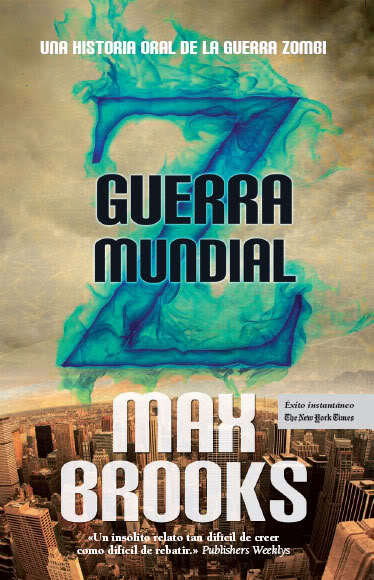World War Z: An Oral History of the Zombie War
is a 2006 apocalyptic horror novel by Max Brooks. It is a follow-up to his 2003 satirical survival manual, The Zombie Survival Guide, but is much more serious in its tone.
 Autor: BROOKS, MAX
Autor: BROOKS, MAXEditorial: ALMUZARA
Año de edición: 2008
Género: Fantástica, ciencia ficción
ISBN: 9788496968813
Synopsis:
An expert UN investigator (Brad Pitt) is forced to try to stop what could be the end of the world in a race against time and fate. The destruction to which is subjected the human race makes him travel the world searching for answers on how to stop the horrible pandemic trying to save the lives of millions of strangers as well as his own family.
Zombie Virus Possible?
As a science fiction writer, Slonczewski is used to imagining doomsday scenarios. Her 2010 novel Brain Plague featured zombie-like characters that bite people to transmit intelligent microbes, which then communicate with the infected person’s brain cells. So I asked her: Could a zombie-like virus occur in real life?
Sort of. No one’s expecting the dead to rise again, of course, but there are so-called neurotropic viruses that attack our brains and cause aggressive or bizarre behavior.
“I suppose you could imagine a [new neurotropic] virus that would cut off the higher brain function and then induce a starvation-like state and could thereby induce the disabled person to go after brains”—the classic zombie meal, Slonczewski said.
Some existing neurotropic viruses are already the stuff of nightmares. For instance, “rabies is pretty scary on its own,” said Kartik Chandran, a microbiologist and immunologist at the Albert Einstein College in New York who studies the deadly Ebola virus. (In the movie and book, the zombie plague is first misidentified as rabies.)
Like the mythical zombie virus, rabies is transferred through biting. Once inside your body, the virus travels directly to your brain and “makes you go nuts and go and bite more people,” he said. More than 55,000 people, mostly in Africa and Asia, die from rabies every year, which is one person every ten minutes, according to the World Rabies Day website. Most infected people are bitten by rabid wildlife. (See “New, Fast-Evolving Rabies Virus Found—And Spreading.”)
Making of a Monster
How would a “zombie virus” arise? One possibility is that two viruses could join together and form a hybrid.
Viruses work by copying their genetic material within human cells. If there are two viruses in the same cell, one virus may accidentally jump on a genetic copy that belongs to the other virus. The progenitor to the human HIV virus may have arisen this way in Africa when a chimpanzee and monkey virus combined, Chandran explained.
But there’s another way that a mutant virus can arise: if there’s a glitch in the genetic copying machinery of an existing virus. Sometimes, one of these mutations confers an advantage to the virus that allows the mutated strain to outcompete others and quickly take over the world. (Take an infectious diseases quiz.)
Called a “selective sweep,” this usually happens frequently with influenza. (See video: “How Flu Viruses Attack.”)
That’s why the concept of a World War Z-like viral plague is not so far-fetched.
Viruses also succeed when they encounter populations that have no immunity against them. A good example is measles in the New World in the 1600s, noted Chandran. Europeans, who were resistant to measles virus, brought it with them to the Americas, where the natives weren’t. It spread like wildfire.
Viruses Not All Bad
But before you panic about a zombie apocalypse, remember that not all viruses are bad. Slonczewski noted that there are more helpful viruses than harmful ones. Some viruses are even essential to our survival, performing functions like stimulating our immune system.
Chandran agreed that “viruses are indispensable to life as we know it.” For instance, viruses shuffle nature’s genetic deck by constantly moving new genetic material from species to species.
Another thing to consider: The majority of viruses on Earth infect single-celled microbes, and have no interest in us humans.
“We’re kind of a sideshow. This whole planet’s really about microbes,” Chandran said, “just waiting to take it back.”
That should put your mind at ease.
















